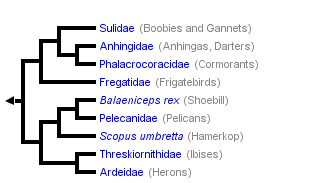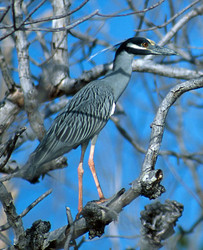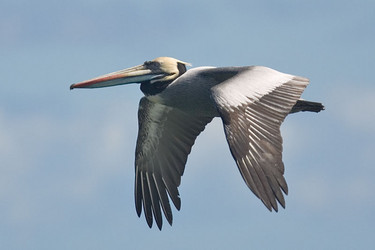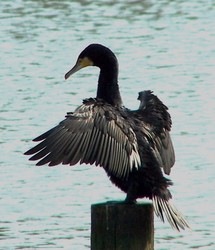Pelecaniformes
Joseph W. Brown and John Harshman


This tree diagram shows the relationships between several groups of organisms.
The root of the current tree connects the organisms featured in this tree to their containing group and the rest of the Tree of Life. The basal branching point in the tree represents the ancestor of the other groups in the tree. This ancestor diversified over time into several descendent subgroups, which are represented as internal nodes and terminal taxa to the right.

You can click on the root to travel down the Tree of Life all the way to the root of all Life, and you can click on the names of descendent subgroups to travel up the Tree of Life all the way to individual species.
For more information on ToL tree formatting, please see Interpreting the Tree or Classification. To learn more about phylogenetic trees, please visit our Phylogenetic Biology pages.
close boxPhylogenetic hypothesis based on Hackett et al. (2008).
Discussion of Phylogenetic Relationships
Traditionally, Pelecaniformes also includes the family Phaethontidae (tropicbirds), which is only distantly related to the other families. Several families included here are traditionally considered to belong to Ciconiiformes: Threskiornithidae, Ardeidae, Balaeniceps, and Scopus (Hackett et al. 2008).
References
Cracraft, J. 1985. Monophyly and the phylogenetic relationships of the Pelecaniformes: a numerical cladistic analysis. Auk 102: 834-853.
Cracraft, J., F. Keith Barker, M. J. Braun, J. Harshman, G. Dyke, J. Feinstein, S. Stanley, A. Cibois, P. Schikler, P. Beresford, J. García-Moreno, M. D. Sorenson, T. Yuri, and D. P. Mindell. 2004. Phylogenetic Relationships Among Modern Birds (Neornithes): Toward an Avian Tree of Life. Pp 468-489 in Cracraft, J. and M. J. Donoghue (eds.), Assembling the Tree of Life. Oxford University Press, New York.
Fain, M. G., and P. Houde. 2004. Parallel radiations in the primary clades of birds. Evolution 58:2558-2573.
Hackett, S. J., Kimball, R. T., Reddy, S., Bowie, R. C. K., Braun, E. L., Braun, M. J., Chojnowski, J. L., Cox, W. A., Han, K.-L., Harshman, J., Huddleston, C. J., Marks, B. D., Miglia, K. J., Moore, W. A., Sheldon, F. H., Steadman, D. W., Witt, C. C., and Yuri, T. 2008. A phylogenomic study of birds reveals their evolutionary history. Science 320(5884):1763-1768.
Hedges, S. B., and Sibley, C. G. 1994. Molecules vs. morphology in avian evolution: The case of the "pelecaniform" birds. Proc. Natl. Acad. Sci. USA 91: 9861-9865.
Johnsgaard, P. A. 1993. Cormorants, Darters, and Pelicans of the World. Smithsonian Institution Press, Washington DC.
Kennedy, M., Holland, B.R., Gray, R.D., and Spencer, H.G. 2005. Untangling long branches: Identifying conflicting phylogenetic signals a priori using spectral analysis, neighbor-net, and consensus networks. Systematic Biology 54:620-633.
Kennedy, M. and H. G. Spencer. 2004. Phylogenies of the frigatebirds (Fregatidae) and tropicbirds (Phaethontidae), two divergent groups of the traditional order Pelecaniformes, inferred from mitochondrial DNA sequences. Molecular Phylogenetics and Evolution 31:31-38.
Kennedy, M., H. G. Spencer, and R. D. Gray. 2000. Hop, step and gape: do the social displays of the Pelecaniformes reflect phylogeny? Animal Behaviour 51: 273-291.
Livezey, B. C., and R. L. Zusi. 2007. Higher-order phylogeny of modern birds (Theropoda, Aves: Neornithes) based on comparative anatomy. II. Analysis and discussion. Zool. J. Linn. Soc. 149:1-95.
Mayr, G. 2003. On the phylogenetic relationships of trogons (Aves, Trogonidae). J. Avian Biol. 34:81-88.
Nelson, J. B. 2006. Pelicans, Cormorants, and Their Relatives: The Pelecaniformes. Bird Families of the World. Oxford University Press, Oxford, New York.
Sheldon, F. H. and B. Slikas. 1997. Advances in Ciconiiform Systematics. Colonial Waterbirds 20(1):106-114.
Sibley, C. G. and J. E. Ahlquist. 1990. Phylogeny and classification of birds: a study in molecular evolution. Yale University Press, New Haven.
Siegel-Causey, D. 1997. Phylogeny of the Pelecaniformes: molecular systematics of a privative group. Pp 159-171 in Mindell, D. P. (ed.), Avian Molecular Evolution and Systematics. Academic Press, San Diego.
van Tuinen, M., D. B. Butvill, J. A. W. Kirsch, and S. B. Hedges. 2001. Convergence and divergence in the evolution of aquatic birds. Proc. R. Soc. Lond. B 268:1345-1350.
Title Illustrations

| Scientific Name | Nycticorax nycticorax |
|---|---|
| Location | Caye Caulker, Belize |
| Creator | John J. Mosesso |
| Specimen Condition | Live Specimen |
| Source Collection | NBII Digital Image Library |
| Scientific Name | Pelecanus thagus |
|---|---|
| Location | Chile |
| Specimen Condition | Live Specimen |
| Source | Peruvian Pelican Pelecanus thagus |
| Copyright |
© 2005 Arthur Grosset

|
| Scientific Name | Phalacrocorax carbo |
|---|---|
| Location | Japan |
| Specimen Condition | Live Specimen |
| Source | Clothes Drying |
| Source Collection | Flickr |
| Image Use |
 This media file is licensed under the Creative Commons Attribution-ShareAlike License - Version 2.0. This media file is licensed under the Creative Commons Attribution-ShareAlike License - Version 2.0.
|
| Copyright | © 2004 Charles Lam |
About This Page
Joseph W. Brown

University of Michigan Museum of Zoology, Ann Arbor, Michigan, USA
Correspondence regarding this page should be directed to Joseph W. Brown at and John Harshman at
Page copyright © 2008 Joseph W. Brown and
 Page: Tree of Life
Pelecaniformes.
Authored by
Joseph W. Brown and John Harshman.
The TEXT of this page is licensed under the
Creative Commons Attribution-NonCommercial License - Version 3.0. Note that images and other media
featured on this page are each governed by their own license, and they may or may not be available
for reuse. Click on an image or a media link to access the media data window, which provides the
relevant licensing information. For the general terms and conditions of ToL material reuse and
redistribution, please see the Tree of Life Copyright
Policies.
Page: Tree of Life
Pelecaniformes.
Authored by
Joseph W. Brown and John Harshman.
The TEXT of this page is licensed under the
Creative Commons Attribution-NonCommercial License - Version 3.0. Note that images and other media
featured on this page are each governed by their own license, and they may or may not be available
for reuse. Click on an image or a media link to access the media data window, which provides the
relevant licensing information. For the general terms and conditions of ToL material reuse and
redistribution, please see the Tree of Life Copyright
Policies.
- First online 14 December 2005
- Content changed 27 June 2008
Citing this page:
Brown, Joseph W. and John Harshman. 2008. Pelecaniformes. Version 27 June 2008 (under construction). http://tolweb.org/Pelecaniformes/57152/2008.06.27 in The Tree of Life Web Project, http://tolweb.org/











 Go to quick links
Go to quick search
Go to navigation for this section of the ToL site
Go to detailed links for the ToL site
Go to quick links
Go to quick search
Go to navigation for this section of the ToL site
Go to detailed links for the ToL site